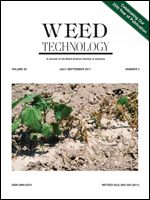Field and laboratory experiments were conducted in New Jersey to investigate the influence of nitrogen on annual bluegrass and creeping bentgrass metabolism and responses to bispyribac-sodium. In field experiments, withholding nitrogen during the test period increased sensitivity of both grasses to bispyribac-sodium, and grasses fertilized biweekly had darker color on most rating dates. Nitrogen generally increased annual bluegrass tolerance to bispyribac-sodium at 74 g ha−1 but not at 148 g ha−1. Creeping bentgrass was influenced by nitrogen at both herbicide rates. In laboratory experiments, weekly nitrogen treatments increased 14C-bispyribac-sodium metabolism in both grasses compared to unfertilized plants. Annual bluegrass metabolized approximately 50% less herbicide regardless of nitrogen regime compared to creeping bentgrass. Overall, routine nitrogen fertilization appears to improve annual bluegrass and creeping bentgrass tolerance to bispyribac-sodium, which may be attributed to higher metabolism.
Nomenclature: Bispyribac-sodium; annual bluegrass, Poa annua L.; creeping bentgrass, Agrostis stolonifera L., ‘L-93’.





